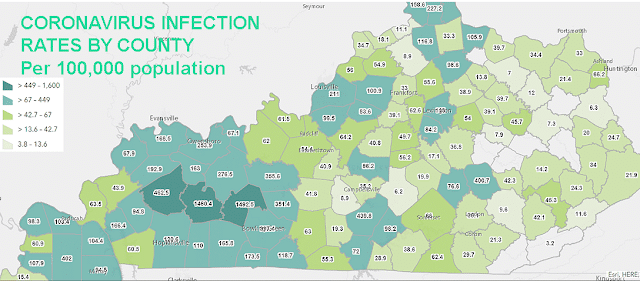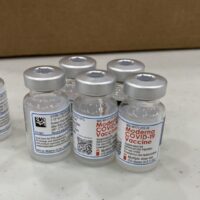The most commonly seen map of coronavirus cases in Kentucky shows the number confirmed in each county, but the more instructive map is the one that shows the rate: the number of cases per 100,000 population. That map shows the top counties are Butler, which has had a major outbreak in its nursing home; Muhlenberg, site of a state prison where all inmates and employees were tested after an outbreak; and Hopkins, the county that had the first major outbreak.

Every county bordering the three also has an elevated infection rate. High rates are also found in Adair and Jackson counties, sites of outbreaks in nursing homes, and bordering counties. Long-term-care facilities have accounted for 58 percent of covid-19 deaths in Kentucky. The Adair County facility has had both of the employee deaths.
Case and death numbers were not updated Sunday because Gov. Andy Beshear took the day off for Mother’s Day.
A coronavirus expert told a Louisville judge Thursday that more inmates at the Green River Correctional Complex in Central City will surely become infected with it and die. The chances of that not happening are “near zero,” said Dr. Frank LoVecchio, a public-health and emergency medicine specialist who is advising the state of Arizona on the virus. “I would put this as very critical.” Three inmates have died.
LoVecchio was “testifying for an inmate who claims he should be released from the Muhlenberg County prison because his confinement there constitutes cruel and unusual punishment,” Andrew Wolfson reports for the Louisville Courier Journal. “LoVecchio also told Jefferson Circuit Judge Brian Edwards that the state’s plan to house infected inmates together may make them sicker.”
Inmate Kaylan Irvin argues that he should be released to home confinement because the state can’t make the prison safe. His attorney, Rob Eggert, said of his client and other prisoners, “They were convicted of crimes, but they weren’t sentenced to death.”
The state is segregating inmates into four buildings: one for those who have the covid-19 disease; one for those who have tested positive but have no symptoms; one for those who have tested negative but have been exposed; and those who are considered medically fragile. Beshear said the configuration of the prison made it possible to move inmates, a step medium-security prison officials don’t like to take.
LoVecchio “conceded that housing infected inmates together would be permissible if there was no other choice and that it was better than putting an infected inmate in a cell with someone who does not have the virus,” Wolfson reports. But Louisville physician Frances Weinstock, testified that it will be “extremely difficult if not impossible” to prevent the spread of the virus, since 40 percent of inmates are infected.
The judge gave the state until Tuesday to respond to an order issued by the 6th U.S. Circuit Court of Appeals that “appears to allow judges to release inmates because of uncontrolled outbreaks of the virus,” Wolfson reports. “It came in a case filed by four inmates at the Federal Correctional Institution in Elkton, Ohio, where eight inmates have died from covid-19.”





